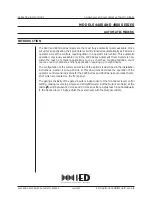
6
AM844D USB
English
42. AUX Send 1, 2 and 3/4 Master Controls
These controls adjust the final level of the AUX1, 2, 3 and 4
signals (as taken from the appropriate AUX level controls on
channel strips) before being sent to the AUX sends. These mixes
can be sent to the Control Room / Phones mix by pushing the
corresponding SOLO buttons.
43. AUX Send Solo Buttons
Push these buttons to send the signals from the corresponding
AUX Sends mixes to the Control Room / Phones mix. The AUX
3 mix will be sent to the left of the Control Room / Phones stereo
mix, while the AUX 4 will be sent to the right.
44. Solo Control
When one or more solo buttons are activated on any channel, this
control adjusts the signals’ levels before sending the amplified
signal to the Control Room / Phones mixing bus. This enables
the user to be able to switch between monitoring the Main L-R (or
other selected signals) and the solo signals without being over-
whelmed by the difference in signal levels.
45. 2T / USB Return Controls
Turning the 2T Return level control adjusts the signal level of
the feed from the 2T Return inputs, as well as the return signal
from the computer through the USB interface. The “To Main L-R”
button that accompanies this control allows users to send the 2T/
USB return signal to the Main stereo mix. When this is done, the
return signal is not sent to the Record Out, as to avoid producing
a feedback loop when recorded signals are fed back into the 2T
return.
46. Control Room / Phones Controls
These two controls are used to adjust the audio level of the
Control Room and Phones feeds, for use in the monitoring and
tracking of audio. The Control Room control adjusts the final level
sent to the C-R outputs on the rear of the AM844D USB mixer,
whereas the Phones control adjusts the final signal sent to the
Phones A and B jacks on the top of the mixer’s face.
47. Control Room / Phones Source Selection
These four buttons allow users to select the various possible
sources for the Control Room and Phones outputs. By simply
pushing one of these buttons, users have the ability to monitor
the Group 1-2, Group 3-4, Main L-R and 2T Return (by the Ctrl
Rm / Phones only button) signals, either together or individually.
Priority
Signal
High
From Solo
Low
Selected Source(s)
48. +48V Indicator
This indicator will illuminate when Phantom Power is activated.
49. Power Indicator
The Power Indicator will light up when the power of the mixer is
on; in case you weren’t too sure.
50. Level Meter
This dual 12 segment level meter gives an accurate indication
of when audio levels of the Main L/R signal reach certain levels.
The 0 dB indicator illuminates is approximately equal to an output
level of +4 dBu (balanced), and the PEAK indicator illuminates
about 1.5 dB before the signal is dynamically clipped. To make
the maximum use of audio, set the various level controls so that
it sits steadily around 0 dB to make full use of audio, while still
maintaining fantastic clarity.
When the Solo indicator, located beside the Level Meter, is
illuminated, one or more Solo buttons has been pushed; therefore
the Level meter will display properties of the Solo signal, which
is helpful with setting of channel properties. If Solo indicator
illuminates green, this means the Solo feed is a pre-fader signal.
If the solo indicator illuminates red, the feed is post-fader. If no
Solo buttons are activated, the Control Room / Phones selected
sources (Main L-R, Group 1-2, Group 3-4 and/or 2T Return)
signal properties are displayed by the Level Meter. In this case,
the Level meter will display the sum of the selected signals.
42
43
46
45
44
47
48 49
50
Summary of Contents for AM844D USB
Page 1: ...AM844D USB User s Manual Manual del Usuario...
Page 19: ...Appendix Ap ndice 5 AM844D USB MEMO...
Page 20: ......






































